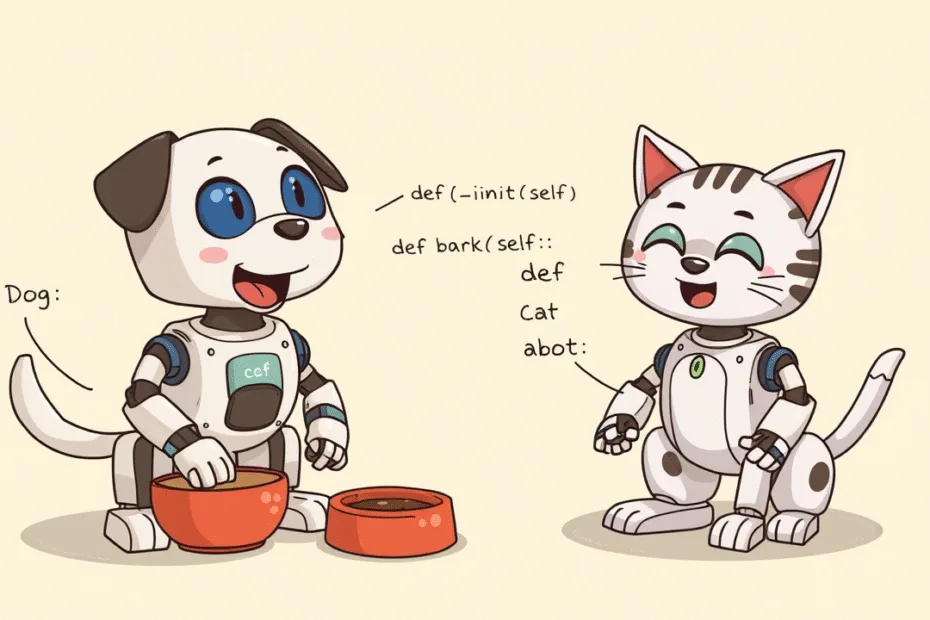Let’s Start Python Programming For Beginners to Advanced. Classes & Objects, Lectures 16
🐍 Lecture 16: Classes & Objects
🎯 Goal
By the end of this lecture, you will:
- Understand what classes and objects are.
- Know how to define a class and create objects from it.
- Be able to add attributes (variables) and methods (functions) to a class.
- Build your first object-oriented Python program.
🧠 What Are Classes and Objects?
So far, we’ve used variables, functions, and data structures like lists and dictionaries. But when programs get big, we need a better way to organize code.
This is where object-oriented programming (OOP) comes in.
Object-Oriented Programming (OOP)
- A way to think about programming using objects.
- Each object has data (attributes) and actions (methods).
🧒 Kids Corner: Think of a car as an object. It has color, speed, and brand (attributes). It can drive, stop, and honk (methods).
🔑 Key Concepts
| Term | Meaning |
|---|---|
| Class | Ablueprintfor creating objects. Like a recipe for cookies. |
| Object | An instance of a class. Like one cookie made from the recipe. |
| Attribute | Variables inside a class — describe the object. |
| Method | Functions inside a class — actions the object can do. |
🏗️ Defining a Class
We use the keyword class to define a blueprint.
Example: Dog Class
class Dog:
def __init__(self, name):
self.name = name
def bark(self):
print("Woof!")
# Creating objects
dog1 = Dog("Buddy")
dog2 = Dog("Max")
# Using attributes and methods
print(dog1.name)
dog2.bark()👉 Output:
Buddy
Woof!Let’s break this down:
__init__()It is a special function called when we create an object.self.namecreates an attribute to store the dog’s name.bark()is a method that makes the dog “bark”.
🧩 Anatomy of a Class
class ClassName:
def __init__(self, param1, param2):
self.attribute1 = param1
self.attribute2 = param2
def method_name(self):
# Code hereYou can give each object its unique data.

🧪 Try It Yourself!
Write a simple class called Cat, and make two cat objects.
Example:
class Cat:
def __init__(self, name):
self.name = name
def meow(self):
print(f"{self.name} says Meow!")
whiskers = Cat("Whiskers")
luna = Cat("Luna")
whiskers.meow()
luna.meow()👉 Output:
Whiskers says Meow!
Luna says Meow!🚀 Challenge (Optional)
Make a Car class with:
- Attributes:
brand,color,speed - Method:
drive()that prints"The [color] [brand] is driving!"
Example:
class Car:
def __init__(self, brand, color):
self.brand = brand
self.color = color
def drive(self):
print(f"The {self.color} {self.brand} is driving!")
my_car = Car("Tesla", "red")
my_car.drive()👉 Output:
The red Tesla is driving!👩🏫 Teaching Tips
🧠 When explaining classes and objects:
- Use real-life examples kids understand: toys, animals, games.
- Compare classes to recipes, objects to the food you cook.
- Encourage students to run the code and try changing names or adding new features.
🤖 Robot says:
I am learning how to be a robot dog now!📌 Summary
- A class is a blueprint for making objects.
- An object is a specific instance of a class.
- You define a class using
class. - Use
__init__()to set up attributes. - Methods are functions inside a class that describe what an object can do.
Stay Updated
If you found this information useful, don’t forget to bookmark this page and Share and leave your feedback in the comment section below.
Python Programming For Beginners To Advanced
Python Programming For Beginners! Lecture 1
Python Programming! Variables and Data Types | Lectures 2
Python Programming! Input And Output | Lectures 3
Python Programming! Operators in Python Lectures 4
Python Programming! Conditional Statements Lectures 5
Python! Loops For and While | Lectures 6
Python! Building A Mini Game | Lectures 7
Python! Functions | Lectures 8
Python! Storing Multiple Values | Lectures 9
Python! Tuples Sets And Dictionaries | Lectures 10
Python! Working with Strings | Lectures 11
Python Programming! File Handling | Lectures 12
Python Programming! Error Handling | Lectures 13
Python! Modules And Packages | Lectures 14
Python Programming! File Handling | Lectures 15
Python! Classes And Objects | Lectures 16
Python! Inheritance | Lectures 17

